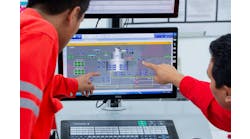It wasn’t too long ago when plant managers complained of too much data. Collecting it was easy, but parsing that data and turning it into something useful was entirely another story. Organizations were drowning in data.
Software companies heard their cries for help and began working on floatation devices in the form of analytics. Now, data has become big data, and manufacturers are looking to use it not only to automate ERP data entry, but to measure productivity and profitability, to virtualize processes and engineering capacity, to monitor equipment health and to gain a strategic advantage over competitors through advanced analytics that turn information into business intelligence.
We asked our panel of nine experts how diagnostic tools have nudged the development of analytic software and vice versa.
Q: How have analytics affected the development of diagnostic tools?
They will continue to grow centralized until the complexity becomes unmanageable, and then they will start to decentralize and to offload complexity to the device level. Devices will become more intelligent with more diagnostic tools as centralized systems focus on managing and organizing incoming post-process information.
Bob Drexel is product manager, process sensors, at ifm efector.
Tom Edwards is senior applications engineer at Opto 22.
Rather than rely on historical information to make decisions, the dynamics of the current business environment require manufacturers to anticipate change in order to take appropriate measures in time to make a difference. As new technologies and new ways of doing things surface, more companies feel the need to use the solutions and more employees throughout the enterprise want more and better decision-support tools. Advanced techniques can be used with big data to discover new facts and relationships that can potentially be used to business advantage. This is a very significant trend, reinforced by the fact that modern predictive analytics tools don’t necessarily require advanced skills to use them. Instead, business users can now get the information via advanced analytical tools they can use themselves.
Many of the early applications at the intersection of machine learning and IIoT will be in predictive or prescriptive maintenance. This class of application promises a tangible, rapid return on investment through the benefits accrued by helping eliminate unplanned down-time. Machine learning applications are self-modifying, highly automated, and embedded. That is, machine learning algorithms are designed to continuously adapt and improve their performance with minimal human intervention. Machine learning algorithms are also embedded within a process or workflow where they become seamlessly integrated into the process to the point where they are invisible to the user or operator. Machine learning algorithms are in their element solving problems that are too difficult or complicated for human programmers to code.
In asset-intensive industries, one of the fastest-growing applications for machine learning is improving maintenance. The traditional preventive maintenance approach assumes that the likelihood of equipment failure increases with usage. Prescriptive maintenance builds on simple condition monitoring to provide advanced notice of a failure so that appropriate maintenance can be scheduled and performed in advance of the failure. The aim is to give a longer-range prediction of failure, with a higher measure of confidence. Ultimately, the goal is to drive toward zero unscheduled downtime.
Manufacturers use analytics in a number of applications. They benefit by applying analytic techniques to support continuous improvement initiatives, plant performance monitoring, decision support, predictive maintenance, generating KPIs, process control and quality control. Analytics can also be used to identify and correct production anomalies, improve control, and make continuous improvements. The key is finding hidden information that has been overlooked or undervalued and using it to strategic advantage. A modern approach built on data collection and analysis enables manufacturers to develop new techniques that result in greater efficiencies, better yields, and increased production flexibility. This can dramatically improve quality and time to market for new products. Together, analytics, business intelligence and big data provide multiple views of information that enable managers, operators and engineers to collaborate and work together, using real-time data and analysis in an information-driven environment.
Information-driven companies are moving to a culture and business model in which all decisions are made based on analysis of process and business process data. Throughout the organization, these companies employ software to collect, contextualize, visualize and analyze data to gain new insights. Armed with new insights, organizations can anticipate changes and drive better business results. Information-driven companies employ advanced analytics throughout their value networks, business processes and decision-making to support corporate initiatives such as energy management and sustainability programs; global growth initiatives; and innovation in product, process, systems and business models.
Paula Hollywood is senior analyst at ARC Advisory Group.
Brett Burger is principal marketing engineer at National Instruments.
Joe Van Dyke is vice president of operations at Azima DLI.
Weishung Liu is product planner at Fluke Industrial Group.
Higher computing capacity and miniaturized electronics significantly enhance the sensor’s ability. This paves the way for predictive diagnostics tools that will result in tremendous benefits in terms of cost saving, higher efficiencies and reduced downtime.
Mitesh Patel heads Internet of Things for the manufacturing industry solution unit at TCS.
Tim Senkbeil is product line manager, Industrial Connectivity Division, at Belden.
Michael Howard is project engineer at Digital Manufacturing and Design Innovation Institute (DMDII) in Chicago, Illinois.
Homepage image courtesy of Stuart Miles at FreeDigitalPhotos.net





